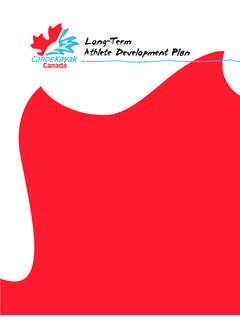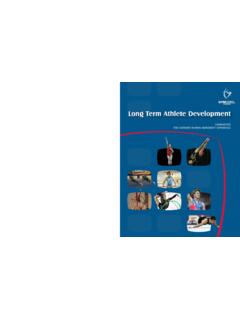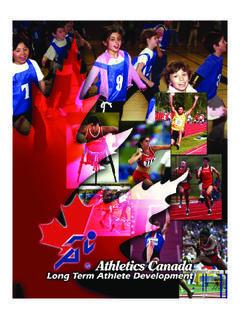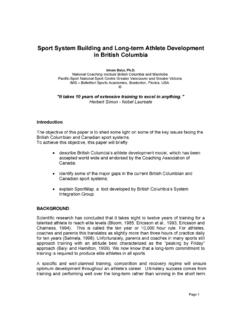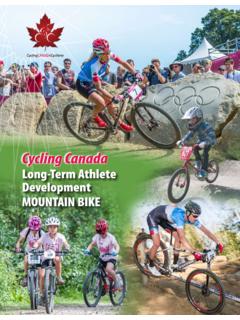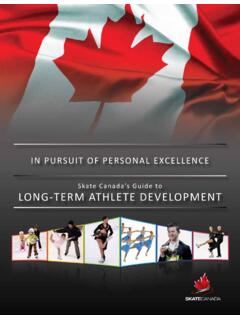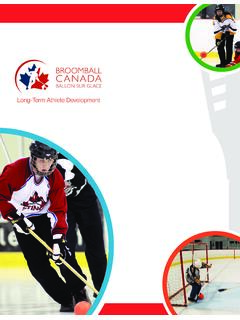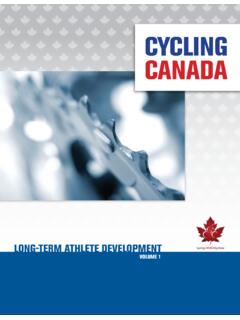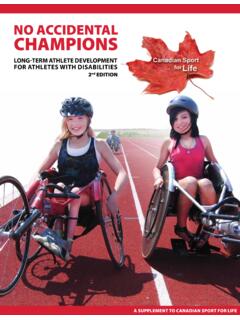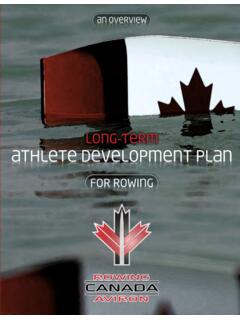Transcription of Long-Term Athlete Development RESOURCE PAPER V2
1 LifeCanadian SportforLong-Term Athlete DevelopmentRESOURCE PAPER V2 Published by the Canadian Sport Centres23 Long-Term Athlete DevelopmentPlanning for the sport excellence and well-being of CanadiansThrough Long-Term Athlete DevelopmentLifeCanadian Sportfor 4 Glossary of terms 7 Overview 8 An Outline of LTAD 13 Introduction14 Sport System Alignment and Integration 17 Shortcomings and Consequences19 The 10 Key Factors Influencing LTAD19 The 10-Year Rule20 The FUNdamentals 22 Specialization 23 Developmental Age25 Trainability 28 Physical, Mental, Cognitive.
2 And Emotional Development28 Periodization31 Calendar Planning for Competition32 System Alignment and Integration34 Continuous Improvement 36 Stages of LTAD37 Active Start38 FUNdamentals40 Learning to Train41 Training to Train 42 Training to Compete43 Training to Win 44 Active for Life 46 Impact of LTAD46 On Parents46 On Coaching47 On the Sport System47 On Sport Science48 On the Education System Canadian Sport Working Together46 On Clubs and Community Sport and Recreation49 Implementation50 Summary52 Selected Bibliography 54 Appendix 1 Physical, Mental, Cognitive, and Emotional Development62 Appendix 2 65 AcknowledgementsTable of ContentsSport Specific Charts4 Glossary of TermsAdaptation refers to a response to a stimulus or a series of stimuli that induces functional and/or morphological changes in the organism.
3 Naturally, the level or degree of adaptation is dependent upon the genetical endowment of an individual. However, the general trends or patterns of adaptation are identified by physiological research, and guidelines are clearly delineated of the various adaptation processes, such as adaptation to muscular endurance or maximum is a difficult period to define in terms of the time of its onset and termination. During this period, most bodily systems become adult both structurally and functionally. Structurally, adolescence begins with an acceleration in the rate of growth in stature, which marks the onset of the adolescent growth spurt.
4 The rate of statural growth reaches a peak, begins a slower or decelerative phase, and finally terminates with the attainment of adult stature. Functionally, adolescence is usually viewed in terms of sexual maturation, which begins with changes in the neuroendocrine system prior to overt physical changes and terminates with the attainment of mature reproductive Capacities refer to the knowledge and experience base of an Athlete and includes warm-up and cool-down procedures, stretching, nutrition, hydration, rest, recovery, restoration, regeneration, metal preparation, and taper and peak.
5 The more knowledgeable athletes are about these training and performance factors, the more they can enhance their training and performance levels. When athletes reach their genetic potential and physiologically cannot improve anymore, performance can be improved by using the ancillary capacities to full ordinarily spans the end of infancy the first birthday to the start of adolescence and is characterized by relatively steady progress in growth and maturation and rapid progress in neuromuscular or motor Development . It is often divided into early childhood, which includes pre-school children aged 1 to 5 years, and late childhood, which includes elementary school-age children, aged 6 through to the onset of adolescence.
6 Chronological age refers to the number of years and days elapsed since birth. Growth, Development , and maturation operate in a time framework; that is, the child s chronological age. Children of the same chronological age can differ by several years in their level of biological maturation. The integrated nature of growth and maturation is achieved by the interaction of genes, hormones, nutrients, and the physical and psychosocial environments in which the individual lives. This complex interaction regulates the child s growth, neuromuscular maturation, sexual maturation, and general physical metamorphosis during the first 2 decades of life.
7 Critical periods of Development refers to a point in the Development of a specific behaviour when experience or training has an optimal effect on Development . The same experience, introduced at an earlier or later time, has no effect on or retards later skill refers to the interrelationship between growth and maturation in relation to the passage of time. The concept of Development also includes the social, emotional, intellectual, and motor realms of the child. 5 Long-Term Athlete DevelopmentThe terms growth and maturation are often used together and sometimes synonymously.
8 However, each refers to specific biological activities. Growth refers to observable, step-by-step, measurable changes in body size such as height, weight, and percentage of body fat. Maturation refers to qualitative system changes, both structural and functional in nature, in the organism s progress toward maturity; for example, the change of cartilage to bone in the skeleton. Peak height velocity (PHV) is the maximum rate of growth in stature during growth spurt. The age of maximum velocity of growth is called the age at strength velocity (PSV) is the maximum rate of increase in strength during growth spurt.
9 The age of maximum increase in strength is called the age at weight velocity (PWV) is the maximum rate of increase in weight during growth spurt. The age of maximum increase in weight is called the age at literacy refers to the mastering of fundamental motor skills and fundamental sport growth is commonly, although sometimes arbitrarily, divided into 3 or 4 age periods, including infancy, childhood, adolescence, and refers to the point at which an individual is sexually mature and able to reproduce. Readiness refers to the child s level of growth, maturity, and Development that enables him/her to perform tasks and meet demands through training and competition.
10 Readiness and critical periods of trainability during growth and Development of young athletes are also referred to as the correct time for the programming of certain stimuli to achieve optimum adaptation with regard to motor skills, muscular and/or aerobic age refers to the maturity of the skeleton determined by the degree of ossification of the bone structure. It is a measure of age that takes into consideration how far given bones have progressed toward maturity, not in size, but with respect to shape and position to one refers to the genetic endowment of athletes as they respond individually to specific stimuli and adapt to it accordingly.

